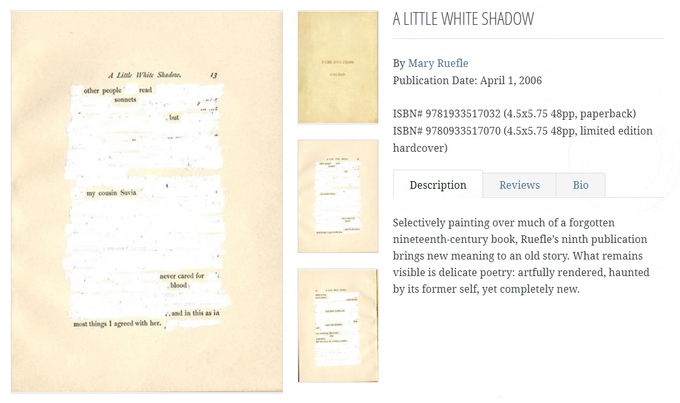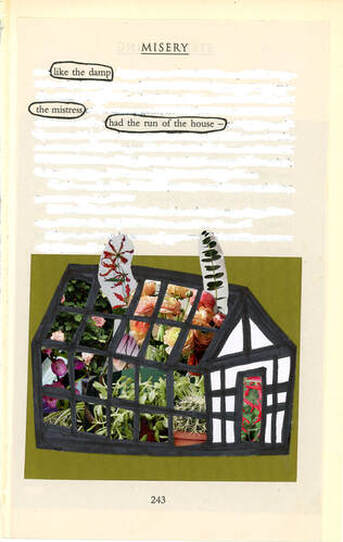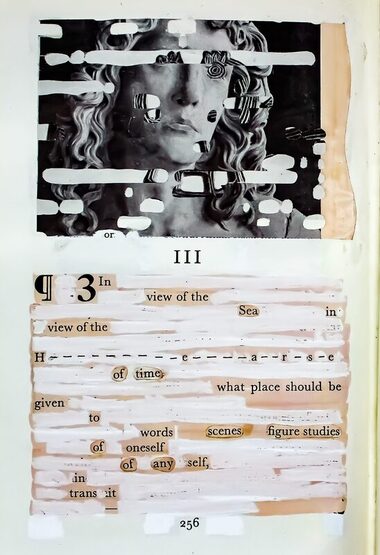I have been witnessing developments of Visual Erasure Poetry since I came to the United States.
The first erasure poetry book I purchased was Mary Ruefle's A Little White Shadow (Wave Books, May 1, 2006).
This beautifully tiny book connected me to current erasure poets who adapt their own erasure techniques.
If Ruefle's "A Little White Shadow" is a mother of visual erasure books - - using a gallon of whiteout - - her decedents (we) are developing our own adaptations of this genre.
I though that it is interesting to see how poets develop their own interpretations of erasure poetry.
The first erasure poetry book I purchased was Mary Ruefle's A Little White Shadow (Wave Books, May 1, 2006).
This beautifully tiny book connected me to current erasure poets who adapt their own erasure techniques.
If Ruefle's "A Little White Shadow" is a mother of visual erasure books - - using a gallon of whiteout - - her decedents (we) are developing our own adaptations of this genre.
I though that it is interesting to see how poets develop their own interpretations of erasure poetry.
The most important and crucial first step for erasure poetry is to THOUGHTFULLY choose an original book.
Ruefle's choice was "Selectively painting over much of a forgotten nineteenth-century book".
Sarah Sloat's Hotel Almighty (Sarabande Books, 2020) erased words from the famous American psychological horror novel Misery by Stephen King.
Both chose interesting original texts.
Then, when I read Sloat's works, I immediately thought that they were branching out from Ruefle's techniques.
Ruefle's choice was "Selectively painting over much of a forgotten nineteenth-century book".
Sarah Sloat's Hotel Almighty (Sarabande Books, 2020) erased words from the famous American psychological horror novel Misery by Stephen King.
Both chose interesting original texts.
Then, when I read Sloat's works, I immediately thought that they were branching out from Ruefle's techniques.
This is one example picture from Sarah Sloat's "Hotel Almighty". There are circles and colorful collages alongside her whited-out words. Also, there are many polka-dots in her collection.
When I talked to her at an online event, she shared a funny episode at an international airport with me. The security officer stopped her because she was carrying a large hole puncher (for her colorful dots).
I asked, "Did you explain your erasure projects?"
She said, "I did not go there. It would be not be worth it."
*
What I like about Sloat's works, is she created additional images from her text after erasing. The erasure voice is like secret murmurs, like wise-words.
Here is an interesting conversation at Tupelo Quarterly:
When I talked to her at an online event, she shared a funny episode at an international airport with me. The security officer stopped her because she was carrying a large hole puncher (for her colorful dots).
I asked, "Did you explain your erasure projects?"
She said, "I did not go there. It would be not be worth it."
*
What I like about Sloat's works, is she created additional images from her text after erasing. The erasure voice is like secret murmurs, like wise-words.
Here is an interesting conversation at Tupelo Quarterly:
Victoria Chang: I love what you say about avoiding “brilliant texts that you admire.” I think about this myself when writing. The more I love a poem or a book, the more I put it as far away as I can when I’m writing my own work.
I read in a bio somewhere that you are fond of the aphorist Georg Christoph Lichtenberg. Many of the poems in your book felt like found aphorisms to me, or perhaps made aphorisms from found language (both in their length and in their spirit). What relationship does the aphorism have to your work?
Sarah Sloat: I love aphorisms and keep a notebook of them. I especially love Lichtenberg. Aphorisms and poetry are close relatives. They can overlap. The aphorism escorts you through an observation, or works through a thought as a poem might, and yields a truth or revelation, however low-key it might be.
I have published some prose poems that use aphorisms. In this book I didn’t set out to find them. But limited as I was to one page for each piece, I’m not surprised some aphoristic fragments turned up.
Then, Jennifer Sperry Steinorth’s Her Read a Graphic Poem develops this further.
Her source text, The Meaning of Art by Herbert Read, was printed in London by Faber & Faber Limited in 1931.
(Interesting original text, check.)
Steinorth erases words to create poetic compositions with her feminist point of view.
There is a technique to find a feminist voice from the 20th century male-dominated original text. Her new voice is a full palette of humor that inhabits her manuscript, sometimes irreverently.
Her source text, The Meaning of Art by Herbert Read, was printed in London by Faber & Faber Limited in 1931.
(Interesting original text, check.)
Steinorth erases words to create poetic compositions with her feminist point of view.
There is a technique to find a feminist voice from the 20th century male-dominated original text. Her new voice is a full palette of humor that inhabits her manuscript, sometimes irreverently.
Sloat and Steinorth also utilized stitching, clothes, and small objects... The outcome is much more playful than just whiting out text.
In addition, there are new adaptations of erasure poems every month. My current favorite is by Kelsey Zimmerman.
In addition, there are new adaptations of erasure poems every month. My current favorite is by Kelsey Zimmerman.




